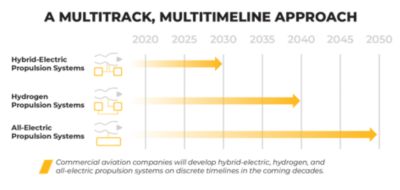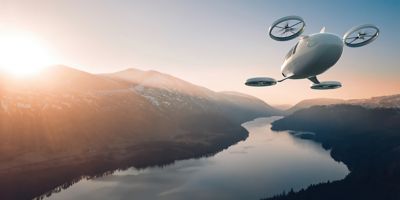-
United States -
United Kingdom -
India -
France -
Deutschland -
Italia -
日本 -
대한민국 -
中国 -
台灣
-
Ansysは、シミュレーションエンジニアリングソフトウェアを学生に無償で提供することで、未来を拓く学生たちの助けとなることを目指しています。
-
Ansysは、シミュレーションエンジニアリングソフトウェアを学生に無償で提供することで、未来を拓く学生たちの助けとなることを目指しています。
-
Ansysは、シミュレーションエンジニアリングソフトウェアを学生に無償で提供することで、未来を拓く学生たちの助けとなることを目指しています。
ANSYS BLOG
May 11, 2023
Sustainability is Changing Commercial Aviation
It is estimated that the commercial aviation industry adds more than 1 billion tons of carbon dioxide (CO2) to the atmosphere annually. That number is expected to increase in the coming years as the economic effects of the COVID-19 pandemic dissipate and the number of global air travelers rises. The International Air Transport Association estimates that by 2040, nearly 8 billion travelers will take flight per year, up from about 4 billion today.1
This landscape raises concerns about the sustainability of commercial aviation. For companies in the industry, the answer is simple: Develop more sustainable aircraft propulsion systems. Simple, however, does not mean easy. Each new propulsion technology has its own merits and presents its own unique challenges. As a result, aviation companies must simultaneously pursue multiple solutions, developing each on independent timelines. This multitrack, multitimeline approach will enable companies to explore the most sustainable propulsion system options for everything from smaller planes and advanced air mobility (AAM) aircraft — which will be the first to benefit as technologies mature — to larger aircraft.

The Multitrack, Multitimeline Approach
The lack of a singular sustainable aircraft propulsion solution is not the only factor leading aviation companies to adopt a segmented development approach. To unlock the significant potential improvements these new systems represent and ensure their viability and safety, companies must also address numerous technical challenges that complicate the design process of the new systems.
Hybrid-electric systems pose system architecture optimization challenges, for example. All-electric systems create challenges related to electric machine design, energy management, and battery efficiency. Hydrogen systems would need to be stored as liquids to reduce volume, which presents cryogenic storage challenges and distribution of liquid hydrogen fuel.
These wide-ranging issues — and the varying levels of technological maturity each system has reached — mean that their development timelines are different. Hybrid-electric systems are likely to reach viability within a decade, but the others will take longer. Hydrogen systems are estimated to reach that point in the mid-2030s, with large-scale adoption of all-electric systems in smaller aircraft becoming a reality around 2050.

The Advantages of a Segmented Approach
The complexity of developing distinct products on distinct timelines may seem like a burden for commercial aviation companies, but this approach offers significant benefits. One such benefit is flexibility. The multitrack, multiple timeline approach allows the industry to focus their efforts on whichever propulsion systems they feel offer the best opportunities and business cases for the markets they serve.
The Advanced air mobility (AAM) market represents an example of that kind of opportunity. AAM vehicles are small, often-autonomous aircraft that can transport people or goods over short distances. In the near-term, these aircraft represent the most feasible application for all-electric propulsion systems. Smaller aviation companies may even disrupt the market by developing electric vertical take-off and landing (eVTOL) vehicles alongside their larger competitors.

Flexibility is also critical in the development of these systems for another important reason: Companies cannot yet know what technological innovations may occur within the estimated development timelines. Many aviation companies are working with technology partners, universities, and government investors to secure the technological breakthroughs needed to support sustainable propulsion. Those in the industry must remain agile as these breakthroughs occur. Companies might reassess their focus if there is a breakthrough in the use of sustainable aviation fuel (SAF), a biofuel that performs similarly to traditional jet fuel but produces fewer emissions. Perhaps advancements in the use of hydrogen as a fuel will make pursuit of an all-electric system unnecessary. Whatever happens, companies will want the freedom to shift the focus of their time and resources if needed, while simultaneously establishing a foundation that sets them up to reach the big picture goal of improving commercial aircraft sustainability.
Looking to the Future
Commercial aviation is poised to change in a big way in the decades ahead. Though the full effects of the industry’s drive for more sustainable aircraft may not be felt for decades, aviation companies must begin their pursuit of that goal now.
The path toward greater sustainability is paved with both obstacles and opportunities. In their pursuit of environmentally friendly commercial air travel, companies must find ways to overcome the technical challenges presented by hybrid-electric, all-electric, and hydrogen propulsion systems. But they can also explore new technologies and find applications and markets for these systems, driving innovation and opening the door to fresh business opportunities.
Adopting a multitrack, multi-timeline strategy for developing the propulsion systems highlighted in this blog allows the aviation industry to reach their short- and long-term sustainability goals and maximize their opportunities to discover other exciting applications and markets.
Read the white paper “Hybrid & Electric Propulsion Systems for Sustainable Aviation” to learn about the drivers, technical challenges, and solutions for these next-generation propulsion systems.
References
- “Global Outlook for Air Transport: Sustained Recovery Against Strong Headwinds.” IATA, December 2022.










